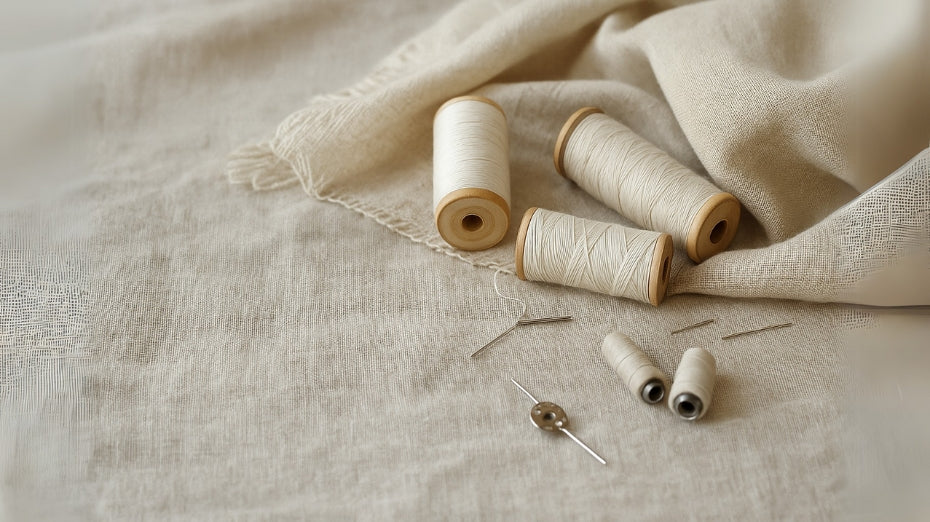The linen: the fabric that we connect to cool summer mornings, minimalist sophistication, and ageless ease has thousands of years of history to tell. At Linenwear, we believe all clothing tells a story. When it comes to linen, that story begins in the soil - and ultimately ends as something you wear, love, and live in.
So, how does a humble plant become a luxurious fabric loved by conscious dressers around the world? We're taking you behind the scenes on the beautiful earthy journey of linen from nature to needle.
|
Table of Content : 1. The Origin: Flax Fields in Bloom 2. Harvesting: A Gentle Uprooting 3. Retting: Unlocking Nature’s Fibers 4. Breaking, Scutching, and Hackling: Refining the Raw 5. Spinning: Turning Fiber into Thread 6. Weaving: Crafting the Fabric 7. Designing and Sewing: The Human Touch 8. Wearing Linen: Where the Journey Continues |
1. The Origin: Flax Fields in Bloom
Linen, in its purest form, starts with flax a hardy, blue-flowering plant which develops in cooler climates. Flax requires little water, needs little pesticides, and grows well in temperate conditions. Flax is primarily grown in various parts of Europe (heavily in France, Belgium, and the Netherlands) given its ideal climate.
Flax is a low impact crop, and as such linen is one of the greatest sustainable fabrics in the world. Flax has many usages, including, seeds for oil, the stalks which are for fiber, and the rest is feed or insulation for animals. Flax has little waste.
2. Harvesting: A Gentle Uprooting
Flax is not cut like many crops but rather is pulled from the soil by hand or machine to maximize the length of the fibers, ensuring optimum strength and quality; this all contributes to linen's famous durability.
After the flax is harvested, the plants are dried and then undergo a key process called retting - the first significant step to releasing the fibers trapped within the stem.
3. Retting: Unlocking Nature’s Fibers
Retting refers to a process where the flax stalk's inner fibers are loosened from the woody core. This process is usually done in a natural environment, by laying flax in fields and letting dew, rain, and/or microbes do the job through a process called field retting.
This process can take several weeks, and while it seems straightforward, it takes monitoring and observation to determine when the flax is perfectly ready, and skill and patience to achieve the proper result. If the flax is not retted properly, the fibers could be damaged or the softness and strength of the fibers lost.
4. Breaking, Scutching, and Hackling: Refining the Raw
After adding water and drying, the flax is ready for transformation. This is accomplished by three mechanical operations:
Breaking:
Crushing the woody stalks to release the fiber from the part with the core.
Scutching:
Scraping off the remaining wood pieces and any other debris.
Hackling:
Combing the fibers to smooth them out, align them, and separate them into long (line flax) and short (tow flax).
What remains after this stage is pure flax fiber long, lustrous, tactile strands that feel a little like soft hair, and represent the transition from raw plant to textile.
5. Spinning: Turning Fiber into Thread
Here is where the true textile magic unfolds. The flax fibers are spun into yarn using a variety of traditional spinning wheels or modern spinning frames. Depending on the thickness of the yarn, and how tightly the fibers are spun together, you can spin and use yarns for everything from fine shirts and dresses to heavy upholstery or table linens.
Linen yarns have a natural slub texture, small and beautiful irregularities that ultimately give your fabric its character.
6. Weaving: Crafting the Fabric
The yarn is now woven into cloth. The most recognized type of linen fabric is made with a plain weave: strong, breathable, and somewhat textured. However, linen can also be used in twill, herringbone, or even jacquard weaves to achieve various effects.
Depending on the desired finish, woven fabric can then be washed, softened, bleached, or dyed. Some linens retain their earth tones of beige or grey; others can be colored in soft pastels, deep neutrals, or bright colors.
7. Designing and Sewing: The Human Touch
Once the fabric is complete, it returns to the capable hands of designers and artisans who cut, sew, and shape it into clothing. Whether smart shirts, free-flowing gowns, tailored kurta, or a casual co-Ord set, linen's versatility is its beauty.
At Linenwear, each piece is created with this journey in mind combining craftsmanship, sustainability, and simple elegance to provide clothing that feels natural as the fabric it is made from.
8. Wearing Linen: Where the Journey Continues
The process does not end when production is complete. When you don linen, you are not just wearing a fabric, you are continuing its narrative - a narrative that is steeped in nature, cared for through craft, and forward thinking through living with intention.
Linen will soften over time, stretch to fit perfectly, and the folds and creases will hold memories. It's more than a fabric - it is a lifestyle choice. It is an honoring of simplicity, and a celebration of conscious fashion.
Woven by Nature, Perfected by Hand
The journey from small flax seeds in open fields to refined clothes in a closet takes care, patience and respect for nature. It illustrates the beauty of slow fashion and the satisfaction of selecting materials that co-exist with Earth.
At Linenwear we respect that journey and create clothes that respect its origins. Every shirt, dress and kurta tells a larger story the story of when comfort meets sustainability and tradition meets modern elegance.







1 comment
zwtm7e